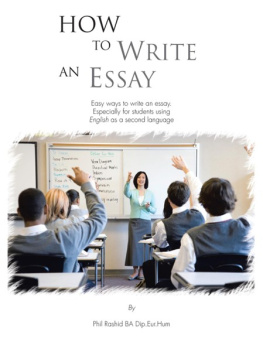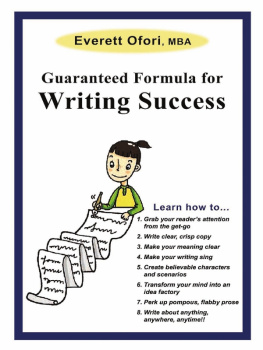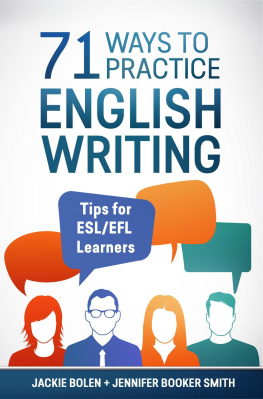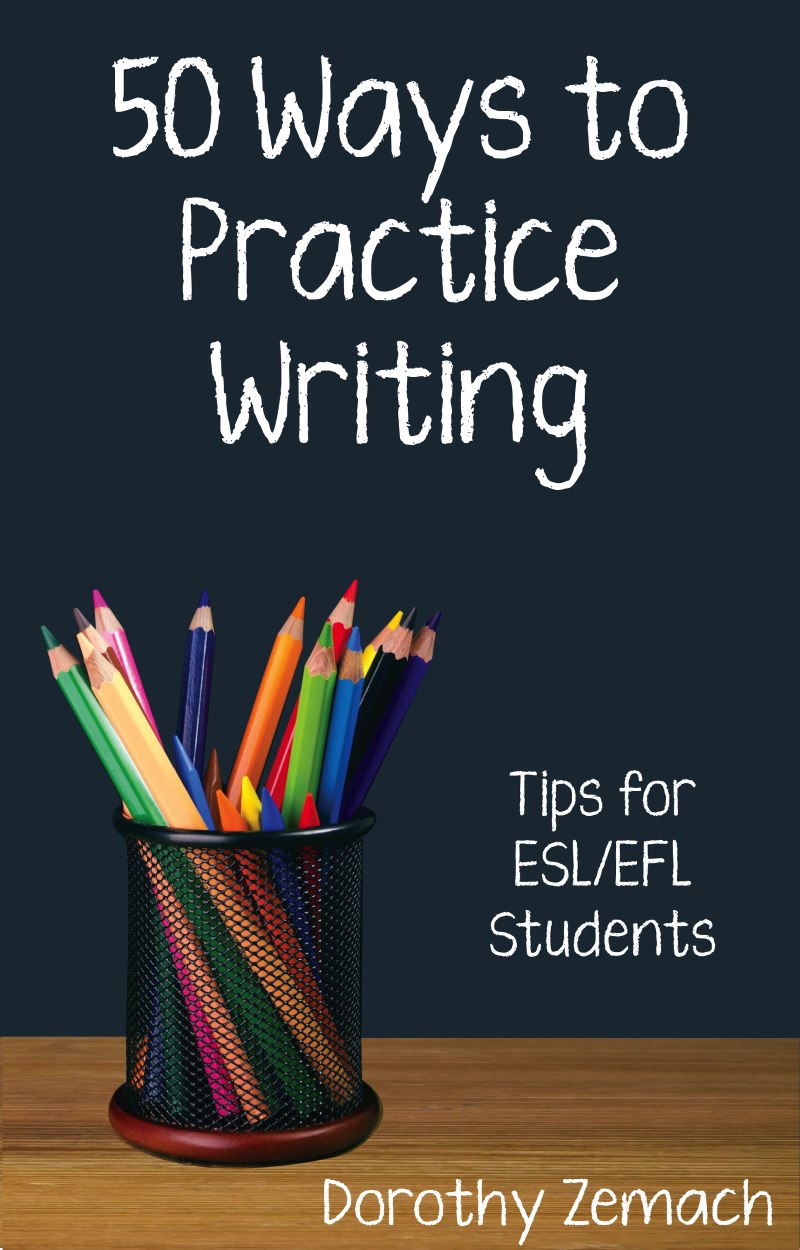Fifty Ways to Practice Writing
Tips for ESL/EFL Students
Dorothy Zemach
Contents
F ifty Ways to Practice Writing : Tips for ESL/EFL Students
Copyright 2013 by Dorothy Zemach
A ll rights reserved . No part of this publication may be reproduced, stored in or introduced into a retrieval system, or transmitted, in any form, or by any means (electronic, mechanical, photocopying, recording, or otherwise) without the prior written permission of the copyright owner.
C over design by DJ Rogers .
Published in the United States by Wayzgoose Press.
How To Use This Book
I t takes many hours to become proficient at anythinga sport, a hobby, a musical instrument, or a foreign language. Many thousands of hours, in fact! For a student of English, this can seem difficult to accomplish, especially if your only opportunity to study English is in the classroom.
This book will help you learn and practice writing in English, both inside and outside the classroom. If you are already taking English classes, some of the tips will help you get more out of your classes. If youre not taking English classes and even if you are other tips will give you ideas to try on your own. Not every idea will work for every student. Thats why there are fifty. We feel sure that many of the ideas presented here will bring you results if you try them sincerely.
Here is a suggested method for using this book:
1) Read through all of the fifty tips without stopping.
2) Read through the tips again. Choose five or six that you think might work for you. Decide when you will try them, and for how long.
3) Try to choose different types of ideas: some for practicing fluency (such as journals or freewriting), some for practicing accuracy, with grammar or punctuation, some for handwriting, and some for typing. Also, choose some that you can practice with a friend or language learning partner, and some that you can do alone. For your convenience, the tips are divided into two main categories, Writing and Typing. The Writing suggestions can almost all be done both with paper and pencil and on a computer; the Typing suggestions are meant for use with a computer or tablet.
4) Each time you use one of the ways, make a note about how well it worked for you and why. Remember that most of the tips will work best if you practice them several times (or even make them a habit). Dont try a tip only once and decide its no good for you. Give the tips you try a few chances, at least.
5) Every few weeks, read through the tips again, and choose some new ones. Discontinue using any methods that are not working for you.
The most important advice, though, is to actually do the suggestions you read about here. Wishing is not working. If you dont do the work, you wont see the results.
Finally, consider trying some of the other books in our 50 Ways to Practice series. No one skill in English is really separate from the others. Speaking, listening, reading, writing, vocabulary, and grammar are all connected. Improving in one area will almost always bring improvements to other areas too.
WRITING (Tips 1-32)
. Use a picture . Find a picture in a magazine and either describe what you see or write a short story about it. Check new vocabulary you need in a dictionary.
. Make a daily habit . Every day, write five sentences in English. If you write in the evening, you can write about what you did during the day. If you write in the morning, you can write about what you are going to do or what you plan/want to do. In this way, you can practice different verb tenses. Why not write both in the morning and in the evening? Keep a notebook and pen or pencil by your bed.
. Keep a journal . Write a journal about any topic that interests you, or keep a diary about the things that happen to you. You can write on paper or on a wordprocessor. You can even keep a journal or diary online, private or public (see Tip #46 on blogs). You dont have to write every day, but you should write several times a week. The more often you write, the faster your writing will improve.
. Practice your handwriting . Even native English speakers need this! If you are someone who spends a lot of time typing or texting, you might not have many chances to practice your handwriting. The best way to improve your handwriting is you guessed it to practice regularly. Get a book of poems or find some online, and copy one each day into a notebook.
. Describe a scene . Watch a DVD or clip from YouTube and then summarize one scene in the movie. Use connecting words like next, then, because, after, while, and so on to connect your sentences and keep the story organized. You can also just describe characters (looks and personality) or a place to practice descriptions.
. Plan a trip . Pick a country and write a paragraph for 15 minutes about what you would do there on a trip. Look up 10 vocabulary words that you will need to write about the trip. Check all spelling and vocabulary after you finish the paragraph. Write it one more time paying attention to spelling.
. Paraphrase 1. Rewrite three sentences in your textbook using different words or by saying the same idea in a different ways.
. Paraphrase 2. For a longer challenge, read a news story of a few paragraphs. Read it several times until you can remember the main ideas and some details. Then, without looking, write the same story in your own words (dont just write sentences that you were able to memorize). When you are finished, compare your version to the original. Were all the facts correct? Did you include the most important ideas? Did you tell the story in a different way (different grammar, different vocabulary)?

. Start a Postcard Club . Find some friends who are also studying English. It doesnt matter if they are in the same city as you or if they live far away. Agree to exchange postcards in English regularly (once a week, once every two weeks, etc.). You will have fun selecting new pictures to send your friends. You can comment on the scene on the card, or just send a friendly message. Remember to start and end your card appropriately: Write the date at the top, begin with Dear (your friends name), and at the end write Your friend (or best wishes), and then sign your name at the very bottom.















